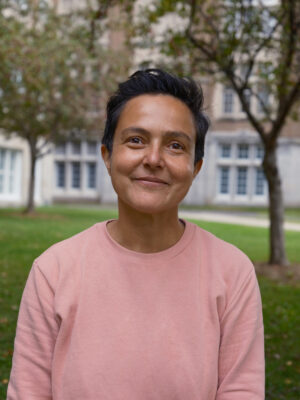
Name pronunciation: Arseli (R-cell-e) Dokumacı (Do-q-ma-dʒ)
Land acknowledgement
Shé:kon! Hi!
My name is Arseli Dokumacı. I am an immigrant settler living on stolen Indigenous Lands, and if I am able to write these lines, work, teach, read, and live a life in Tiohtià:ke, it is because Kanien’kehá:ka Nation have, for centuries, taken care of the Land, and continues to do so despite the colonial settler state. I am grateful to the Kanien’kehá:ka (people of the flint) and to the Land for letting me live here peacefully, enjoy looking at the trees, breathe the air they clean, have access to food and clean drinking water and grow vegetables every summer.
I was born and raised in Turkey and immigrated to Canada. While I am not a descendent of colonizers, I benefit from the multiple infrastructures of the colonial system in so-called Canada. I try to alleviate the harms caused by my settler status and privileges through committing myself to creating and supporting anti-colonialist spaces and initiatives, decolonizing my pedagogical practices and syllabi, and the broader efforts at decolonization within the university and beyond.
About my work
I am interested in the tiny details of everyday life. Like the gesture of a hand or a fleeting glance or a scratch on an everyday object. These details escape our habituated perceptions and slip through the cracks, and I wonder: What stories would these details tell? What meanings do they hold? What worlds do they make? Importantly, what would happen if we didn’t let them slip through the cracks? I seek answers to these questions, sometimes by using the camera, sometimes by drawing, sometimes by talking to people, sometimes by observing and sometimes by merely imagining.
In the past, this fascination has taken me to the following trajectories:
These curiosities have led to a series of projects, artworks and publications, including my first book Activist Affordances: How disabled people improvise more habitable worlds, which is coming out with Duke University Press in January 2023, and my articles, “People as affordances”, “Disability as Method”, and “A Theory of Micro-activist Affordances” which have, respectively, appeared in Current Anthropology, Disability Studies Quarterly, and The South Atlantic Quarterly. My video work, “Activist Affordances” has recently been exhibited as part of the 8th Bienal de Arte Contemporáneo de la Fundación ONCE in Madrid (October 2022), and in the past, I contributed to various national and international exhibitions such as “The Flesh of the World” exhibition (2015) curated by Amanda Cachia.